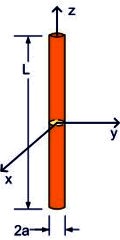Center-Driven Dipole
 |
The dipole antenna is one of the simplest radiating structures. This was chosen as a canonical problem because it is relatively easy to model and analytical solutions are available. We plot the real and imaginary parts of the input impedance as a function of frequency. Codes based on the solution of surface integral equations (e.g. boundary element methods) should be able to solve this problem in a few seconds or less. Differential-equation based codes (e.g. FEM and FDTD methods) are less well-suited to this type of problem, but should still be able to produce an accurate solution in a relatively short time. Modeling Notes:
| |||||||||
| ||||||||||